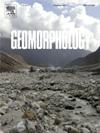Holocene paleoflood stratigraphy in the lower Yellow River floodplain, China
IF 3.1
2区 地球科学
Q2 GEOGRAPHY, PHYSICAL
引用次数: 0
Abstract
The lower Yellow River has experienced enormous floods, levee breaches, and channel avulsions over the last 4000-year history, resulting in the deposition of extensive paleoflood sediments across the North China Plain. However, a comprehensive investigation of paleoflood stratigraphy in alluvial plains is still lacking. Here, representative paleoflood profiles along the abandoned channel areas in the lower Yellow River have been comprehensively and systematically analyzed in terms of sedimentology, stratigraphy, and chronology. Our findings reveal that the subsurface stratigraphy is mainly formed by twelve lithological facies and four facies associations. The facies associations are interpreted to represent lowland, paleosol, overbank and channel environments. Compared with the mutable overbank and channel deposits, lowland and paleosol facies that have been developed during relatively stable periods without flood aggradation can be utilized to refine stratigraphic correlations. By combining stratigraphic evidence and radiometric dating results, four sedimentary units are consistently identified in the study area: Unit I related to the early geomorphic surface before the ∼8.0 ka, Unit II represents stability period during the middle Holocene, Unit III with different sequences of overbank flood deposits and paleosols suggesting an abrupt environmental change since ∼4.0 ka, and Unit IV of widely distributed indicating the frequent cycles of flood and interflood since the last millennium. Furthermore, a sedimentary model of paleofloods with a distinct upward-coarsening sequence along the abandoned channel areas is proposed, illustrating the multi-stage deposition of the flooding process. In particular, the thick layer of uniform silt and clay in the lower Yellow River demonstrates distinct features of slack water deposits, which explores the potential of applying the traditional method to more populated and higher-risk areas on floodplains and similar lower rivers.
求助全文
约1分钟内获得全文
求助全文
来源期刊

Geomorphology
地学-地球科学综合
CiteScore
8.00
自引率
10.30%
发文量
309
审稿时长
3.4 months
期刊介绍:
Our journal''s scope includes geomorphic themes of: tectonics and regional structure; glacial processes and landforms; fluvial sequences, Quaternary environmental change and dating; fluvial processes and landforms; mass movement, slopes and periglacial processes; hillslopes and soil erosion; weathering, karst and soils; aeolian processes and landforms, coastal dunes and arid environments; coastal and marine processes, estuaries and lakes; modelling, theoretical and quantitative geomorphology; DEM, GIS and remote sensing methods and applications; hazards, applied and planetary geomorphology; and volcanics.
 求助内容:
求助内容: 应助结果提醒方式:
应助结果提醒方式:


